2019 MERCEDES-BENZ S CLASS light
[x] Cancel search: lightPage 413 of 578
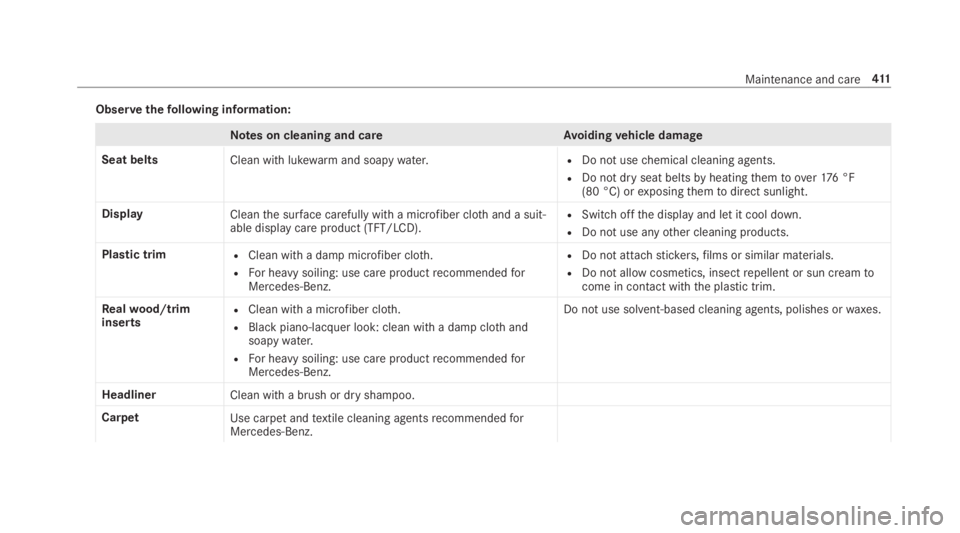
Observethefollowing information:
Notes on cleaning and careAvoidingvehicle damage
Seat beltsClean with lukewarmand soapywater.RDo not usechemical cleaning agents.
RDo not dry seat beltsbyheatingthemtoover176 °F(80 °C) orexposingthemtodirect sunlight.
DisplayCleanthe surface carefully witha microfiber clothand a suit‐able display care product (TFT/LCD).RSwitchoffthe display and let it cool down.
RDo not use anyother cleaning products.
Plastic trimRClean with a damp microfiber cloth.
RFor heavy soiling: use care productrecommendedforMercedes-Benz.
RDo not attachstickers,films or similar materials.
RDo not allow cosmetics, insectrepellent or sun creamtocome in contact with the plastic trim.
Realwood/triminsertsRClean with a microfiber cloth.
RBlackpiano-lacquer look: clean with a damp clothandsoapywater.
RFor heavy soiling: use care productrecommendedforMercedes-Benz.
Do not use solvent-based cleaning agents, polishes orwaxes.
HeadlinerClean with a brush or dry shampoo.
CarpetUse carpet andtextile cleaning agentsrecommendedforMercedes-Benz.
Maintenance and care411
Page 421 of 578
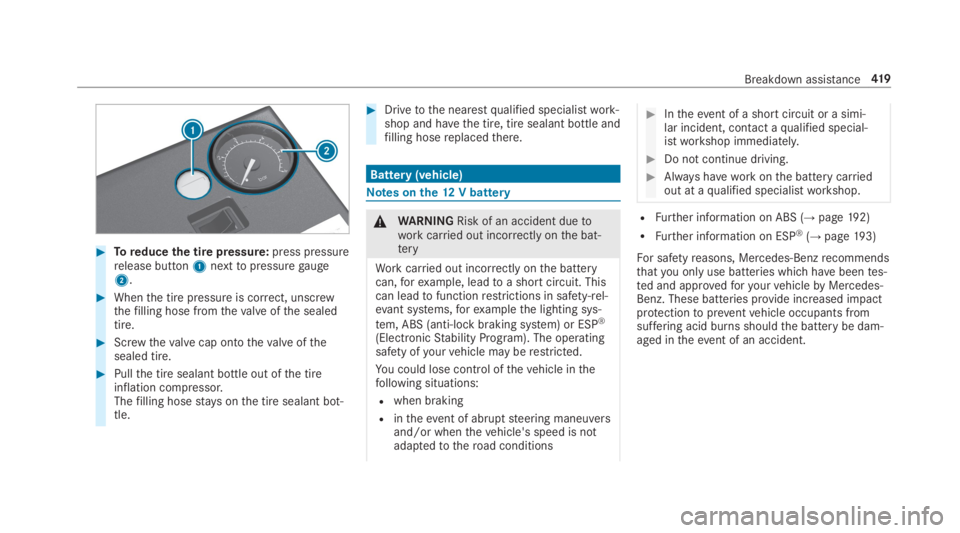
#Toreduce the tire pressure:press pressurerelease button1nexttopressuregauge2.
#Whenthe tire pressure is correct, unscrewthefilling hose fromthevalve ofthe sealedtire.
#Screwthevalve cap ontothevalve ofthesealed tire.
#Pullthe tire sealant bottle out ofthe tireinflation compressor.Thefilling hosestays onthe tire sealant bot‐tle.
#Drivetothe nearestqualified specialistwork‐shop and havethe tire, tire sealant bottle andfilling hosereplacedthere.
Battery(vehicle)
Notes onthe12V battery
&WARNINGRisk of an accident duetoworkcarried out incorrectly onthe bat‐tery
Workcarried out incorrectly onthe batterycan,forexample, leadtoa short circuit. Thiscan leadtofunctionrestrictions in safety-rel‐evant systems,forexamplethe lighting sys‐
tem, ABS (anti-lockbraking system) or ESP®
(ElectronicStability Program). The operatingsafety ofyourvehicle may berestricted.
You could lose control ofthevehicle inthefollowing situations:
Rwhen braking
Rintheevent of abruptsteering maneuversand/or whenthevehicle's speed is notadaptedtotheroad conditions
#Intheevent of a shortcircuit or a simi‐lar incident, contact aqualified special‐istworkshop immediately.
#Do not continue driving.
#Always haveworkonthe battery carriedout at aqualified specialistworkshop.
RFurther information on ABS (→page192)
RFurther information on ESP®(→page193)
For safetyreasons, Mercedes-Benzrecommendsthatyou onlyuse batteries which havebeentes‐ted and approvedforyourvehiclebyMercedes-Benz. These batteries provide increased impactprotectiontopreventvehicle occupants fromsuffering acid burns shouldthe battery be dam‐aged intheevent of an accident.
Breakdown assistance419
Page 424 of 578
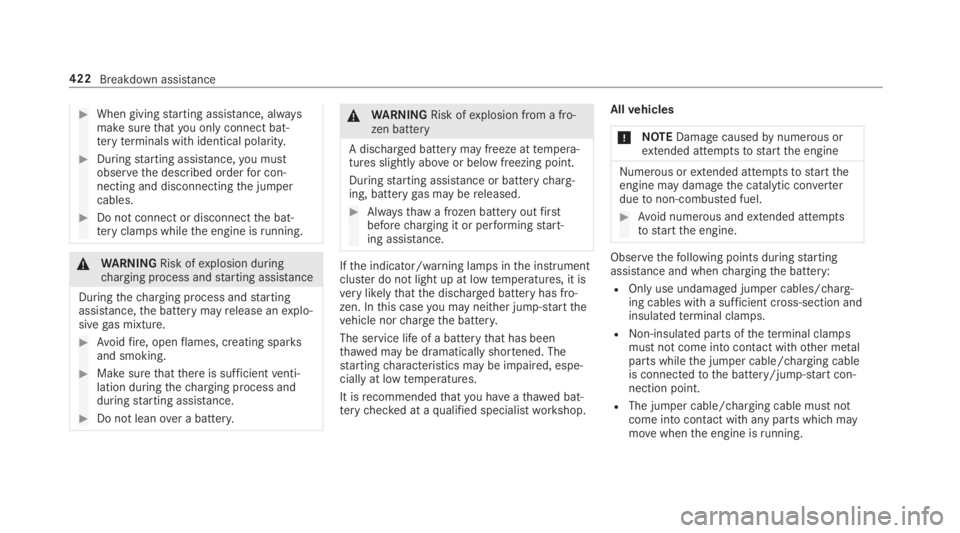
#When givingstarting assistance, alwaysmake surethatyou onlyconnect bat‐teryterminals with identical polarity.
#Duringstarting assistance,you mustobservethe described orderfor con‐necting and disconnectingthe jumpercables.
#Do not connect or disconnectthe bat‐teryclamps whilethe engine isrunning.
&WARNINGRisk ofexplosion duringcharging process andstarting assistance
Duringthecharging process andstartingassistance,the battery mayrelease anexplo‐sivegas mixture.
#Avoidfire, openflames, creating sparksand smoking.
#Make surethatthere is sufficientventi‐lation duringthecharging process andduringstarting assistance.
#Do not leanover a battery.
&WARNINGRisk ofexplosion from a fro‐zen battery
A discharged battery may freeze attempera‐tures slightly aboveor below freezing point.
Duringstarting assistance or batterycharg‐ing, batterygas may bereleased.
#Alwaysthawa frozen batteryoutfirstbeforecharging it or performingstart‐ing assistance.
Ifthe indicator/warning lamps inthe instrumentcluster do not light up at lowtemperatures, it isverylikelythatthe discharged battery has fro‐zen. Inthis caseyou may neither jump-startthevehicle norchargethe battery.
The service life of a batterythat has beenthawed may be dramatically shortened. Thestartingcharacteristics may be impaired, espe‐cially at lowtemperatures.
It isrecommendedthatyou haveathawed bat‐terychecked at aqualified specialistworkshop.
Allvehicles
*NOTEDamagecausedbynumerous orextended attemptstostartthe engine
Numerous orextended attemptstostarttheengine may damagethe catalytic converterduetonon-combusted fuel.
#Avoid numerous andextended attemptstostartthe engine.
Observethefollowing points duringstartingassistance and whenchargingthe battery:
ROnly use undamaged jumper cables/charg‐ing cables with a sufficient cross-section andinsulatedterminal clamps.
RNon-insulated parts oftheterminal clampsmust not come into contact withother metalparts whilethe jumper cable/charging cableis connectedtothe battery/jump-startcon‐nection point.
RThe jumper cable/charging cable must notcome into contact withany parts which maymovewhenthe engine isrunning.
422Breakdown assistance
Page 426 of 578
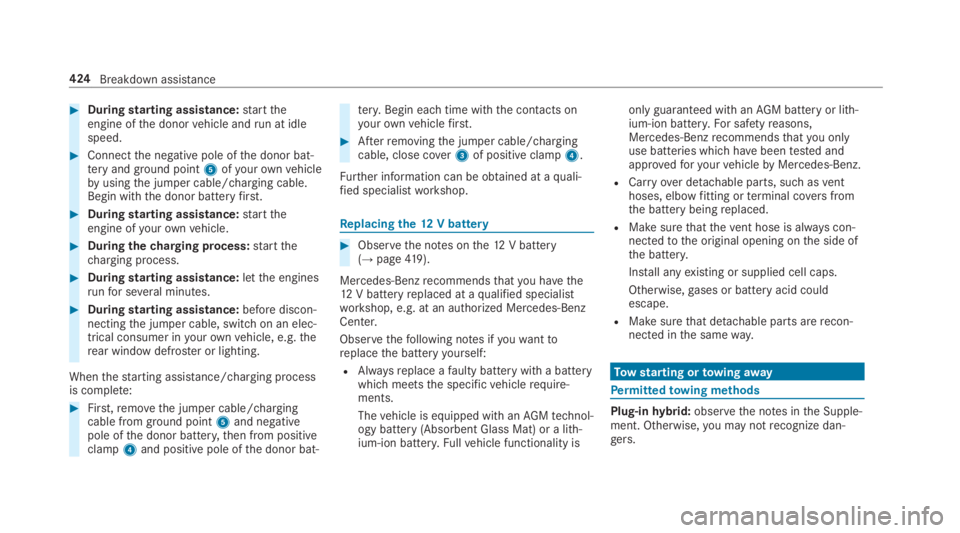
#Duringstarting assistance:starttheengine ofthe donorvehicle andrun at idlespeed.
#Connectthe negative pole ofthe donor bat‐teryandground point5ofyourownvehiclebyusingthe jumper cable/charging cable.Begin withthe donor batteryfirst.
#Duringstarting assistance:starttheengine ofyourownvehicle.
#Duringthecharging process:startthecharging process.
#Duringstarting assistance:letthe enginesrunfor several minutes.
#Duringstarting assistance:before discon‐nectingthe jumper cable, switch on an elec‐trical consumer inyourownvehicle, e.g.therear windowdefroster or lighting.
Whenthestarting assistance/charging processis complete:
#First,removethe jumper cable/chargingcable from ground point5and negativepole ofthe donor battery,then from positiveclamp4and positive pole ofthe donor bat‐
tery. Begin eachtime with the contacts onyourownvehiclefirst.
#Afterremovingthe jumper cable/chargingcable, close cover3of positive clamp4.
Further information can be obtained at aquali‐fied specialistworkshop.
Replacing the12V battery
#Observethe notes onthe12V battery(→page419).
Mercedes-Benzrecommendsthatyou havethe12V batteryreplaced at aqualified specialistworkshop, e.g. at an authorized Mercedes-BenzCenter.
Observethefollowing notes ifyouwanttoreplacethe batteryyourself:
RAlwaysreplace afaulty batterywith a batterywhich meetsthe specificvehiclerequire‐ments.
Thevehicle is equipped with anAGMtechnol‐ogy battery (Absorbent Glass Mat) or a lith‐ium-ion battery.Fullvehicle functionality is
only guaranteed with anAGM battery or lith‐ium-ion battery.For safetyreasons,Mercedes-Benzrecommendsthatyou onlyuse batteries which havebeentested andapprovedforyourvehiclebyMercedes-Benz.
RCarryover detachable parts, such asventhoses, elbowfitting orterminal coversfromthe battery beingreplaced.
RMake surethatthevent hose is alwayscon‐nectedtothe original opening onthe side ofthe battery.
Install anyexisting or supplied cell caps.
Otherwise,gases or battery acid couldescape.
RMake surethat detachable parts arerecon‐nected inthe sameway.
Towstarting ortowingaway
Permittedtowing methods
Plug-inhybrid:observethe notes inthe Supple‐ment. Otherwise,you may notrecognize dan‐gers.
424Breakdown assistance
Page 430 of 578

RThevehicle has been loaded ontothe transporter correctly
RThevehicle is secured at allfourwheels with suitabletensioningstraps
RThe maximum permissible speed of35mph (60 km/h) is notexceededwhen transporting
*NOTEDamagetothevehicle from secur‐ing it incorrectly
#After loading,thevehicle must besecured on allfour wheels. Otherwise,thevehicle could be damaged.
#A minimum distance of 4 in (10 cm)upwards and 8 in (20 cm) downwardsmust bekepttothe transport platform.
Transport level is notavailableforthefollowingvehicles:
RMercedes-AMGvehicles
RVehicles with MAGICBODYCONTROL
%Depending onthe model, button1is loca‐ted inthe control panel betweenthesteeringwheel andthe driver's door.
#Toactivate transportlevel:press button1.Indicator lamp2lights up.
Thevehicle israisedby1.2 in (30 mm) com‐paredtothe normal level.
#Press button1again and hold itfor at leastfiveseconds.Thevehicle israised fromtheraised leveltothe transport level.
The transport level isreached when indicatorlamp2flashes andtheMax. Speed 22mphdisplay message appears inthe multifunctiondisplay.
Thevehicle is lowered again inthefollowing sit‐uations:
RWhen drivingfasterthan 22mph (35 km/h).
RAfter selecting a drive program usingtheDYNAMIC SELECT switch.
Thevehicle isthen adjustedtothe height ofthe last active drive program.
#Securethevehicle on allfour wheels afterloading.
#Todeactivate transportlevel:starttheengine whenthevehicle is at astandstill.If transportlevel is activated, indicator lamp2flashes.
428Breakdown assistance
Page 439 of 578
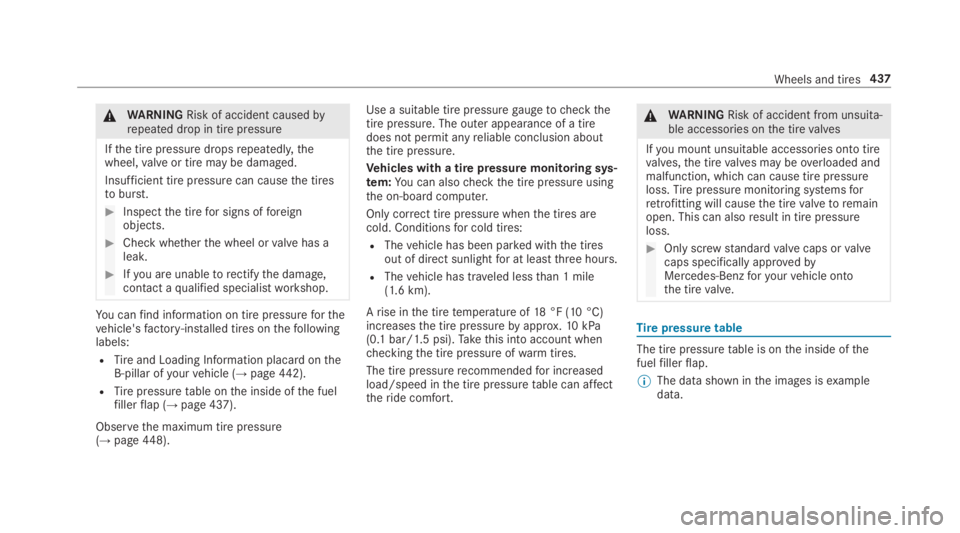
&WARNINGRisk of accident causedbyrepeated drop in tire pressure
Ifthe tire pressure dropsrepeatedly,thewheel,valve or tire may be damaged.
Insufficient tire pressure can causethe tirestoburst.
#Inspectthe tirefor signs offoreignobjects.
#Check whetherthe wheel orvalve has aleak.
#Ifyou are unabletorectifythe damage,contact aqualified specialistworkshop.
You canfind information on tire pressureforthevehicle'sfactory-installed tires onthefollowinglabels:
RTireand Loading Information placard ontheB‑pillar ofyourvehicle (→page442).
RTirepressuretable onthe inside ofthe fuelfillerflap (→page 437).
Observethe maximum tire pressure(→page448).
Use a suitable tire pressuregaugetocheckthetire pressure. The outer appearance of a tiredoes not permit anyreliable conclusion aboutthe tire pressure.
Vehicles with a tire pressure monitoring sys‐tem:You can alsocheckthe tire pressure usingthe on-board computer.
Only correct tire pressure whenthe tires arecold. Conditionsfor cold tires:
RThevehicle has been parked withthe tiresout of direct sunlightfor at leastthree hours.
RThevehicle has traveled lessthan 1 mile(1.6 km).
Arise inthe tiretemperature of18°F (10 °C)increasesthe tire pressurebyapprox.10kPa(0.1 bar/1.5 psi).Takethis into account whencheckingthe tire pressure ofwarmtires.
The tire pressure recommendedfor increasedload/speed inthe tire pressuretable can affecttheride comfort.
&WARNINGRisk of accident from unsuita‐ble accessories onthe tirevalves
Ifyou mount unsuitable accessories ontotirevalves,the tirevalves may beoverloaded andmalfunction, which can cause tire pressureloss.Tirepressure monitoring systemsforretrofitting will causethe tirevalvetoremainopen. This can alsoresult in tire pressureloss.
#Only screwstandardvalve caps orvalvecaps specifically approvedbyMercedes-Benzforyourvehicle ontothe tirevalve.
Tirepressure table
The tire pressuretable is onthe inside ofthefuelfillerflap.
%The data shown inthe images isexampledata.
Wheels and tires437
Page 441 of 578

Furtherrelated subjects:
RNotes on tire pressure (→page 435)
RTirepressuretable (→page 437)
RTireand Loading Information placard(→page442)
Tirepressure monitoring system
Function ofthe tire pressure monitoring sys‐tem
&DANGERRisk of accident duetoincor‐rect tire pressure
Every tire, includingthe spare (if provided),should bechecked when cold at least once amonth and inflatedtothe pressurerecom‐mendedbythevehicle manufacturer (seeTireand Loading Information placard ontheB-pillar onthe driver’sside orthe tire pres‐sure label onthe inside ofthe fuelfillerflapofyourvehicle). Ifyourvehicle has tires of adifferent sizethanthe size indicated ontheTireand Loading Information placard orthe
tire pressuretable,you needtodeterminethe proper tire pressureforthose tires.
As an added safetyfeature,yourvehicle hasbeen equipped with a tire pressure monitor‐ing system (TPMS)that illuminates a low tirepressure indicator lamp when one or more ofyour tires are significantly underinflated.Accordingly, ifthe low tire pressure indicatorlamp lights up,you shouldstop andcheckyour tires as soon as possible, and inflatethemtothe proper pressure. Driving on asignificantly underinflated tire causesthe tiretooverheat and can leadtotirefailure.Underinflation also increases fuel consump‐tion andreduces tire tread life, and mayaffectthevehicle's handling and braking abil‐ity. Please notethatthe TPMS is not a substi‐tutefor proper tire maintenance, and it isthedriver'sresponsibilitytomaintain correct tirepressure,even if underinflation has notreachedthe leveltotrigger illumination ofthe TPMS low tire pressure indicator lamp.
Yourvehicle has also been equipped with aTPMS malfunction indicatortoindicate when
the system is not operating properly. TheTPMS malfunction indicator is combined withthe low tire pressure indicator lamp. Whenthe system detects a malfunction,the indica‐tor lamp willflashfor approximatelya minuteandthenremain continuously illuminated.This sequence will continue upon subsequentvehiclestart-ups as long asthe malfunctionexists.
Whenthe malfunction indicator is illumina‐ted,the system may not be abletodetect orsignal low tire pressure as intended. TPMSmalfunctions may occurfor avariety ofrea‐sons, includingthe installation of incompati‐blereplacement or alternate tires or wheelsonthevehiclethat preventthe TPMS fromfunctioning properly.
Alwayscheckthe TPMS malfunctionwarninglamp afterreplacing one or more tires orwheels onyourvehicletoensurethatthereplacement or alternate tires and wheelsallowthe TPMStocontinuetofunction prop‐erly.
Wheels and tires439
Page 452 of 578

Preceding letter11:RWithout: passengervehicle tires accordingtoEuropean manufacturingstandards.
R"P": passengervehicle tires accordingtoUSmanufacturingstandards.
R"LT": light truck tires accordingtoUS manu‐facturingstandards.
R"T": compact emergency sparewheels withhigh tire pressurethat are only designedfortemporary use in an emergency.
Aspectratio33:Ratio between tire height and tire width in per‐cent (tireheight dividedbytire width).
Tire code44(tiretype):R"R"radial tire
R"D": bias ply tire
R"B": bias belted tires
R"ZR":radial tire with a maximum speed above149mph (240 km/h) (optional)
Rim diameter55:The diameter ofthe bead seat (notthe diameteroftherimflange). Therim diameter is specifiedin inches (in).
Load-bearing index66:Numerical codethat specifiesthe maximumload-bearing capacity of a tire (e.g. "91" corre‐spondsto1356 lbs (615kg)).
The load-bearing capacity ofthe tire must be atleast halfthe permissible axle load ofyourvehi‐cle. Do notoverloadthe tiresbyexceedingthespecified load limit.
See also:
RMaximum permissible load ontheTireandLoading Information placard (→page442)
RMaximum tire load (→page448)
RLoad index
Speedrating77:Specifiesthe approved maximum speed ofthetire.
%An electronic speed limiter preventsyourvehicle fromexceeding a speed of130mph(210km/h).
Makesurethatyour tires havetherequiredspeedrating.You can obtain information ontherequired speedrating from an authorizedMercedes-Benz Center.
Summer tires
IndexSpeedrating
Qupto100mph (160 km/h)
Rupto106mph (170 km/h)
Supto112mph (180 km/h)
Tupto118mph (190 km/h)
Hupto130mph (210km/h)
Vupto149mph (240 km/h)
Wupto168mph (270 km/h)
Yupto186mph (300 km/h)
450Wheels and tires